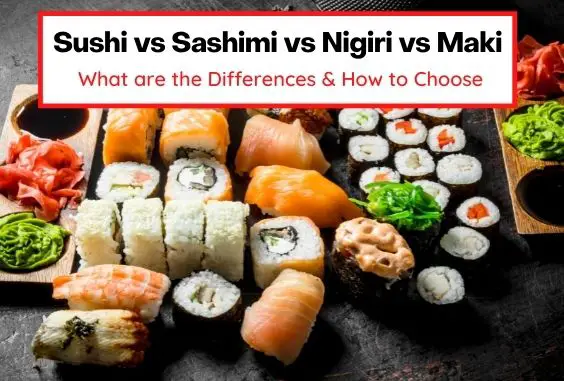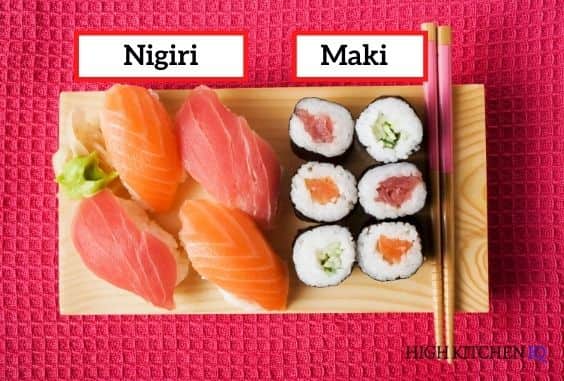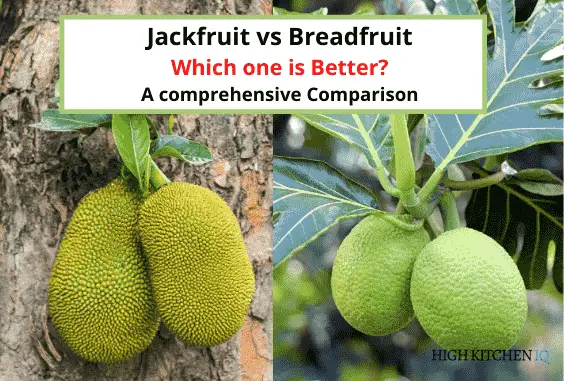Sushi vs Sashimi vs Nigiri vs Maki – What’s the Difference

Visiting any sushi restaurant can be very confusing especially when you are not acquainted with traditional Japanese dishes.
Typically, a sushi menu will have a ton of variations on the different types of sushi (Maki and Nigiri) and it will also feature other similar options such as sashimi.
Now in this article, we will help you to make informed choices by highlighting the differences as well as the similarities between:
- Sushi – Usually made with fish or other ingredients but it must contain vinegar rice to be considered sushi.
- Sashimi – Uses similar ingredients to sushi but does not contain any vinegar rice.
- Maki – A type of sushi made into bite sized rolls
- Nigiri – A type of sushi served as slices of raw fish with vinegar rice.
What is Sushi
Sushi is made from vinegar rice and other ingredients such as fish either cooked or raw, seaweed, cucumbers, avocados mayonnaise, etc.
There are two types of sushi made from different ingredients and presented differently. They are:
- Maki – is usually a bite size roll made of layers of fish, veggies and rice wrapped in a seaweed.
- Nigiri – is a dish of raw slices of fish served over oblong mounds of pressed vinegar rice.
Sushi needs to have rice that has been vinegared, in order to be classed as “sushi.” Sushi rice has a unique flavor and is usually medium-grain white rice that is easy to clump together to prepare the sushi rolls.
And both Maki and Nigiri contain vinegar rice.
What is Sashimi

Sashimi translates to “Pierced meat” and is made of only very thin, expertly sliced strips of raw fish or meat. And is often paired with soy sauce and condiments such as wasabi paste, grated fresh ginger, and shredded daikon radish.
The soy sauce, condiments, and garnishes help to bring out the flavor of the fish and allow the individual flavor to shine without interruption from any other flavors.
Sashimi is made using raw fish like sushi, but it is not made with any vinegar rice so that means that it is not a type of sushi.
You can click here to read about the different types of Sashimi and How they taste.
Types of Sushi
As mentioned there are many different types of sushi with varying ingredients, preparation, and condiments.
There are also subtypes, including handmade sushi, rolled sushi, pressed sushi, and scattered sushi. The two most popular types of sushi are
- Nigiri
- Maki
Differences Between Sashimi vs Sushi
- Sashimi does not have the rice component that is compulsory in sushi.
- Sushi can also be made from raw fish however, sashimi uses more expensive and highly-prized raw seafood which makes the dish more unique.
- Sushi can be made from a variety of ingredients including nori (seaweed), vegetables while sashimi is often served alone with a dipping sauce .
- Sushi can be made using raw or cooked fish while sashimi is made using mostly raw meat.
Video Showing Differences of Sashimi and Sushi
Nutritional Differences Sashimi & Sushi
The nutritional value of sushi or sashimi will vary depending on the type of sushi or sashimi. That is because different types of sushi use different ingredients and sashimi uses a variety of fish or meat that also has varying nutritional value.
Sushi is generally higher in calories, the calories in a full roll of sushi can vary from 135 -505 calories while sashimi calories vary from 25- 65 calories per 1 ounce.
Sushi is also higher in carbs, fats, fiber, and sugar compared to sashimi. But sashimi is made of just raw fish so it has a higher amount of protein and omega-3 fats.
However, when compared to other dishes both are considered healthy dishes that are non-fatty and low in calories.
Comparing the Pros & Cons of Sushi & Sashimi on your Diet
| Positives | Negatives | |
| sushi | 1. Made using a variety of ingredients and is more versatile. 2. Some types of sushi uses fish or meat that is cooked, unlike sashimi where most options are just raw meat. 3. Sushi has more fiber because it often contains vegetables and seaweed which sashimi does not have. 4. There are many varieties of sushi to suit different nutritional needs. 5. More Carbs and vegetables means that sushi might be more fulfilling. | 1. Sushi has more sodium and refined carbs compared to sashimi. 2. More calories in sushi due to additional ingredients. 3. Raw fish in some types of sushi may pose certain risks. |
| Sashimi | 1. Sashimi is higher in omega -3 and protein 2. Sashimi has fewer calories than sushi | 1. Made from raw fish which may pose a risk for higher levels of mercury 2. The taste of raw fish may not be pleasing for everyone 3. Some raw fish in sashimi may contain bacteria such as salmonella or parasites |
Maki Vs Nigiri

What is Maki?
Maki means roll and is one of the most recognizable and popular types of sushi.
It is made from rice with the sushi vinegar combination and raw fish or vegetables that are all rolled up in a sheet of roasted seaweed called nori. Maki is sometimes referred to as Makizushi or norimaki.
What is Nigiri?
Nigiri is derived from the Japanese word Nigirizushi, which basically means “hand-pressed sushi.” Nigiri is a type of sushi consisting of a specially sliced piece of raw fish that has been pressed and compacted over sweet and salty vinegared rice.
There may be a small amount of wasabi between the fish and rice to hold the two together, or a thin strip of toasted seaweed might be used to tie them.
After being pressed together nigiri roll is then chilled so that the taste of the fish combines with the tangy flavor of the rice.
Nigiri vs Sashimi
Nigiri is similar to sashimi, as it is made from raw seafood, usually thinly sliced fish. But what makes nigiri different from sashimi is that it is served over hand-balled vinegared rice.
Another difference is that, since nigiri consists of a small mound of rice, you can eat it by picking it up with your hands or a fork while, sashimi is more delicate and thin, so you have to eat it with chopsticks.
Sashimi and Nigiri also come with different sides and condiments. Nigiri is usually only accompanied by a small ramekin or soy sauce and a dab of wasabi. On the other hand, sashimi is often served with pickled ginger and daikon radish.
Lastly, In terms of calories, sashimi has lower calories than nigiri due to the lack of rice.
Nigiri Vs Maki
Maki and Nigiri differ primarily in the way they are prepared and presented. Listed below are key differences:
- Nigiri is a bite-size rectangular mound of rice topped with a piece of sashimi. Maki, on the other hand, is made in rolls and sliced into round bite-size pieces.
- Maki is made into bite side pieces while nigiri portions tend to be a bit larger.
- Most nigiri is made with sashimi-grade fish laid over the top of rice, while Maki may contain pieces of raw or cooked seafood.
- Maki tends to have more calories than nigiri due to high calorie ingredients such as mayonnaise.

